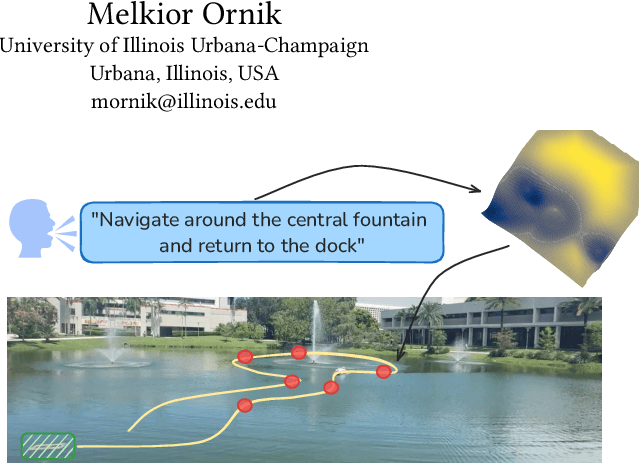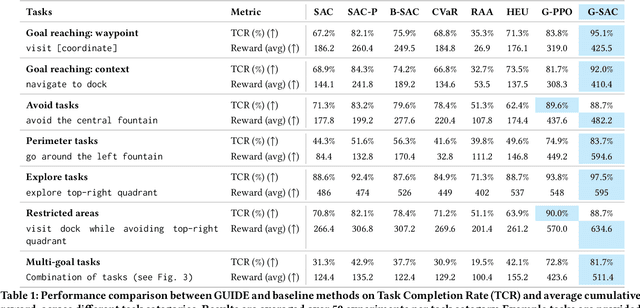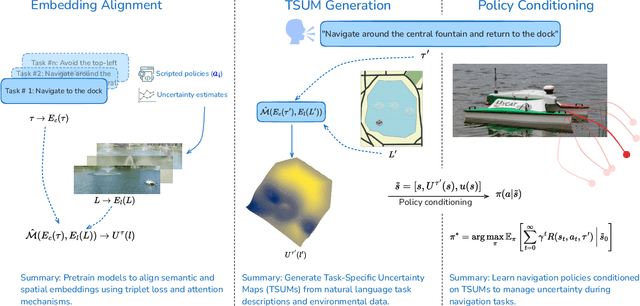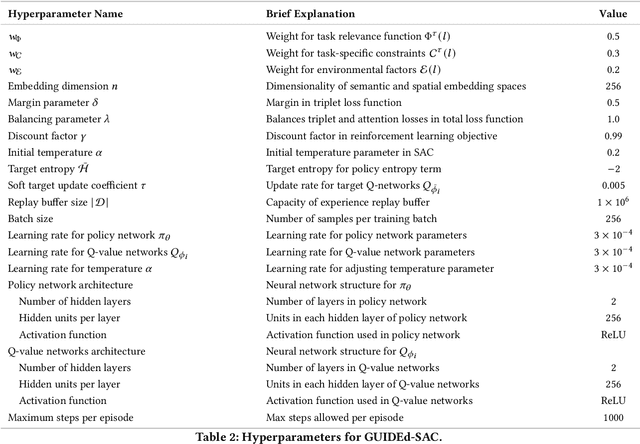Melkior Ornik
Online Learning of Deceptive Policies under Intermittent Observation
Sep 19, 2025Abstract:In supervisory control settings, autonomous systems are not monitored continuously. Instead, monitoring often occurs at sporadic intervals within known bounds. We study the problem of deception, where an agent pursues a private objective while remaining plausibly compliant with a supervisor's reference policy when observations occur. Motivated by the behavior of real, human supervisors, we situate the problem within Theory of Mind: the representation of what an observer believes and expects to see. We show that Theory of Mind can be repurposed to steer online reinforcement learning (RL) toward such deceptive behavior. We model the supervisor's expectations and distill from them a single, calibrated scalar -- the expected evidence of deviation if an observation were to happen now. This scalar combines how unlike the reference and current action distributions appear, with the agent's belief that an observation is imminent. Injected as a state-dependent weight into a KL-regularized policy improvement step within an online RL loop, this scalar informs a closed-form update that smoothly trades off self-interest and compliance, thus sidestepping hand-crafted or heuristic policies. In real-world, real-time hardware experiments on marine (ASV) and aerial (UAV) navigation, our ToM-guided RL runs online, achieves high return and success with observed-trace evidence calibrated to the supervisor's expectations.
Adaptive Stress Testing Black-Box LLM Planners
May 08, 2025Abstract:Large language models (LLMs) have recently demonstrated success in generalizing across decision-making tasks including planning, control and prediction, but their tendency to hallucinate unsafe and undesired outputs poses risks. We argue that detecting such failures is necessary, especially in safety-critical scenarios. Existing black-box methods often detect hallucinations by identifying inconsistencies across multiple samples. Many of these approaches typically introduce prompt perturbations like randomizing detail order or generating adversarial inputs, with the intuition that a confident model should produce stable outputs. We first perform a manual case study showing that other forms of perturbations (e.g., adding noise, removing sensor details) cause LLMs to hallucinate in a driving environment. We then propose a novel method for efficiently searching the space of prompt perturbations using Adaptive Stress Testing (AST) with Monte-Carlo Tree Search (MCTS). Our AST formulation enables discovery of scenarios and prompts that cause language models to act with high uncertainty. By generating MCTS prompt perturbation trees across diverse scenarios, we show that offline analyses can be used at runtime to automatically generate prompts that influence model uncertainty, and to inform real-time trust assessments of an LLM.
Motion Planning and Control with Unknown Nonlinear Dynamics through Predicted Reachability
Mar 05, 2025Abstract:Autonomous motion planning under unknown nonlinear dynamics presents significant challenges. An agent needs to continuously explore the system dynamics to acquire its properties, such as reachability, in order to guide system navigation adaptively. In this paper, we propose a hybrid planning-control framework designed to compute a feasible trajectory toward a target. Our approach involves partitioning the state space and approximating the system by a piecewise affine (PWA) system with constrained control inputs. By abstracting the PWA system into a directed weighted graph, we incrementally update the existence of its edges via affine system identification and reach control theory, introducing a predictive reachability condition by exploiting prior information of the unknown dynamics. Heuristic weights are assigned to edges based on whether their existence is certain or remains indeterminate. Consequently, we propose a framework that adaptively collects and analyzes data during mission execution, continually updates the predictive graph, and synthesizes a controller online based on the graph search outcomes. We demonstrate the efficacy of our approach through simulation scenarios involving a mobile robot operating in unknown terrains, with its unknown dynamics abstracted as a single integrator model.
TAB-Fields: A Maximum Entropy Framework for Mission-Aware Adversarial Planning
Dec 03, 2024Abstract:Autonomous agents operating in adversarial scenarios face a fundamental challenge: while they may know their adversaries' high-level objectives, such as reaching specific destinations within time constraints, the exact policies these adversaries will employ remain unknown. Traditional approaches address this challenge by treating the adversary's state as a partially observable element, leading to a formulation as a Partially Observable Markov Decision Process (POMDP). However, the induced belief-space dynamics in a POMDP require knowledge of the system's transition dynamics, which, in this case, depend on the adversary's unknown policy. Our key observation is that while an adversary's exact policy is unknown, their behavior is necessarily constrained by their mission objectives and the physical environment, allowing us to characterize the space of possible behaviors without assuming specific policies. In this paper, we develop Task-Aware Behavior Fields (TAB-Fields), a representation that captures adversary state distributions over time by computing the most unbiased probability distribution consistent with known constraints. We construct TAB-Fields by solving a constrained optimization problem that minimizes additional assumptions about adversary behavior beyond mission and environmental requirements. We integrate TAB-Fields with standard planning algorithms by introducing TAB-conditioned POMCP, an adaptation of Partially Observable Monte Carlo Planning. Through experiments in simulation with underwater robots and hardware implementations with ground robots, we demonstrate that our approach achieves superior performance compared to baselines that either assume specific adversary policies or neglect mission constraints altogether. Evaluation videos and code are available at https://tab-fields.github.io.
Capacity-Aware Planning and Scheduling in Budget-Constrained Monotonic MDPs: A Meta-RL Approach
Oct 28, 2024Abstract:Many real-world sequential repair problems can be effectively modeled using monotonic Markov Decision Processes (MDPs), where the system state stochastically decreases and can only be increased by performing a restorative action. This work addresses the problem of solving multi-component monotonic MDPs with both budget and capacity constraints. The budget constraint limits the total number of restorative actions and the capacity constraint limits the number of restorative actions that can be performed simultaneously. While prior methods dealt with budget constraints, including capacity constraints in prior methods leads to an exponential increase in computational complexity as the number of components in the MDP grows. We propose a two-step planning approach to address this challenge. First, we partition the components of the multi-component MDP into groups, where the number of groups is determined by the capacity constraint. We achieve this partitioning by solving a Linear Sum Assignment Problem (LSAP). Each group is then allocated a fraction of the total budget proportional to its size. This partitioning effectively decouples the large multi-component MDP into smaller subproblems, which are computationally feasible because the capacity constraint is simplified and the budget constraint can be addressed using existing methods. Subsequently, we use a meta-trained PPO agent to obtain an approximately optimal policy for each group. To validate our approach, we apply it to the problem of scheduling repairs for a large group of industrial robots, constrained by a limited number of repair technicians and a total repair budget. Our results demonstrate that the proposed method outperforms baseline approaches in terms of maximizing the average uptime of the robot swarm, particularly for large swarm sizes.
Enhancing Robot Navigation Policies with Task-Specific Uncertainty Management
Oct 19, 2024



Abstract:Robots performing navigation tasks in complex environments face significant challenges due to uncertainty in state estimation. Effectively managing this uncertainty is crucial, but the optimal approach varies depending on the specific details of the task: different tasks require varying levels of precision in different regions of the environment. For instance, a robot navigating a crowded space might need precise localization near obstacles but can operate effectively with less precise state estimates in open areas. This varying need for certainty in different parts of the environment, depending on the task, calls for policies that can adapt their uncertainty management strategies based on task-specific requirements. In this paper, we present a framework for integrating task-specific uncertainty requirements directly into navigation policies. We introduce Task-Specific Uncertainty Map (TSUM), which represents acceptable levels of state estimation uncertainty across different regions of the operating environment for a given task. Using TSUM, we propose Generalized Uncertainty Integration for Decision-Making and Execution (GUIDE), a policy conditioning framework that incorporates these uncertainty requirements into the robot's decision-making process. We find that conditioning policies on TSUMs provides an effective way to express task-specific uncertainty requirements and enables the robot to reason about the context-dependent value of certainty. We show how integrating GUIDE into reinforcement learning frameworks allows the agent to learn navigation policies without the need for explicit reward engineering to balance task completion and uncertainty management. We evaluate GUIDE on a variety of real-world navigation tasks and find that it demonstrates significant improvements in task completion rates compared to baselines. Evaluation videos can be found at https://guided-agents.github.io.
Autonomous Excavation of Challenging Terrain using Oscillatory Primitives and Adaptive Impedance Control
Sep 26, 2024Abstract:This paper addresses the challenge of autonomous excavation of challenging terrains, in particular those that are prone to jamming and inter-particle adhesion when tackled by a standard penetrate-drag-scoop motion pattern. Inspired by human excavation strategies, our approach incorporates oscillatory rotation elements -- including swivel, twist, and dive motions -- to break up compacted, tangled grains and reduce jamming. We also present an adaptive impedance control method, the Reactive Attractor Impedance Controller (RAIC), that adapts a motion trajectory to unexpected forces during loading in a manner that tracks a trajectory closely when loads are low, but avoids excessive loads when significant resistance is met. Our method is evaluated on four terrains using a robotic arm, demonstrating improved excavation performance across multiple metrics, including volume scooped, protective stop rate, and trajectory completion percentage.
InfraLib: Enabling Reinforcement Learning and Decision Making for Large Scale Infrastructure Management
Sep 05, 2024Abstract:Efficient management of infrastructure systems is crucial for economic stability, sustainability, and public safety. However, infrastructure management is challenging due to the vast scale of systems, stochastic deterioration of components, partial observability, and resource constraints. While data-driven approaches like reinforcement learning (RL) offer a promising avenue for optimizing management policies, their application to infrastructure has been limited by the lack of suitable simulation environments. We introduce InfraLib, a comprehensive framework for modeling and analyzing infrastructure management problems. InfraLib employs a hierarchical, stochastic approach to realistically model infrastructure systems and their deterioration. It supports practical functionality such as modeling component unavailability, cyclical budgets, and catastrophic failures. To facilitate research, InfraLib provides tools for expert data collection, simulation-driven analysis, and visualization. We demonstrate InfraLib's capabilities through case studies on a real-world road network and a synthetic benchmark with 100,000 components.
Solving Truly Massive Budgeted Monotonic POMDPs with Oracle-Guided Meta-Reinforcement Learning
Aug 13, 2024Abstract:Monotonic Partially Observable Markov Decision Processes (POMDPs), where the system state progressively decreases until a restorative action is performed, can be used to model sequential repair problems effectively. This paper considers the problem of solving budget-constrained multi-component monotonic POMDPs, where a finite budget limits the maximal number of restorative actions. For a large number of components, solving such a POMDP using current methods is computationally intractable due to the exponential growth in the state space with an increasing number of components. To address this challenge, we propose a two-step approach. Since the individual components of a budget-constrained multi-component monotonic POMDP are only connected via the shared budget, we first approximate the optimal budget allocation among these components using an approximation of each component POMDP's optimal value function which is obtained through a random forest model. Subsequently, we introduce an oracle-guided meta-trained Proximal Policy Optimization (PPO) algorithm to solve each of the independent budget-constrained single-component monotonic POMDPs. The oracle policy is obtained by performing value iteration on the corresponding monotonic Markov Decision Process (MDP). This two-step method provides scalability in solving truly massive multi-component monotonic POMDPs. To demonstrate the efficacy of our approach, we consider a real-world maintenance scenario that involves inspection and repair of an administrative building by a team of agents within a maintenance budget. Finally, we perform a computational complexity analysis for a varying number of components to show the scalability of the proposed approach.
Few-shot Scooping Under Domain Shift via Simulated Maximal Deployment Gaps
Aug 06, 2024



Abstract:Autonomous lander missions on extraterrestrial bodies need to sample granular materials while coping with domain shifts, even when sampling strategies are extensively tuned on Earth. To tackle this challenge, this paper studies the few-shot scooping problem and proposes a vision-based adaptive scooping strategy that uses the deep kernel Gaussian process method trained with a novel meta-training strategy to learn online from very limited experience on out-of-distribution target terrains. Our Deep Kernel Calibration with Maximal Deployment Gaps (kCMD) strategy explicitly trains a deep kernel model to adapt to large domain shifts by creating simulated maximal deployment gaps from an offline training dataset and training models to overcome these deployment gaps during training. Employed in a Bayesian Optimization sequential decision-making framework, the proposed method allows the robot to perform high-quality scooping actions on out-of-distribution terrains after a few attempts, significantly outperforming non-adaptive methods proposed in the excavation literature as well as other state-of-the-art meta-learning methods. The proposed method also demonstrates zero-shot transfer capability, successfully adapting to the NASA OWLAT platform, which serves as a state-of-the-art simulator for potential future planetary missions. These results demonstrate the potential of training deep models with simulated deployment gaps for more generalizable meta-learning in high-capacity models. Furthermore, they highlight the promise of our method in autonomous lander sampling missions by enabling landers to overcome the deployment gap between Earth and extraterrestrial bodies.
 Add to Chrome
Add to Chrome Add to Firefox
Add to Firefox Add to Edge
Add to Edge